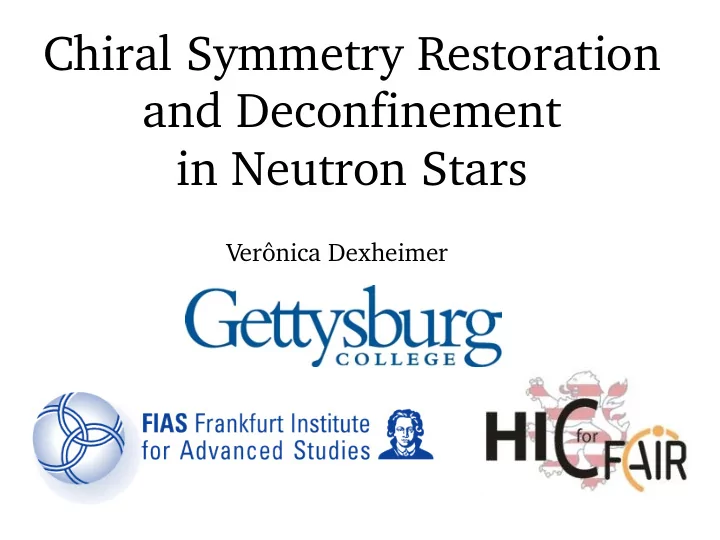

Chiral Symmetry Restoration and Deconfinement in Neutron Stars Verônica Dexheimer
1. Motivation Having a model that can be used for: – small temperatures and high densities neutron stars – high temperatures and small densities heavy ion collisions – everything in the middle Include different degrees of freedom in the same model Study chiral symmetry restoration and deconfinement to quark matter inside compact stars 2
2. Chiral Model _ L R _ M < > M M scalar term breaks symmetry L R Effective mass comes from coupling to field _ M * M * =g _ QCD vacuum filled with qq pairs (not chiral invariant!) 3
Chiral Condensate ( B ,T) The chiral symmetry is restored earlier (smaller chemical potential) 4 for higher temperatures.
3. Composition ● Appearance of heavier (strange) particles as density increases hyperons p, n, , + , 0 , - , 0 , - ++ , + , 0 , - , * + , * 0 , * - , * 0 , * - , ● Amount of each particle not constant ● Chemical equilibrium _ n p + e + e ● Leptons ensure charge neutrality e, 5
● Deconfinement of hadrons e, increase of density B ● New degrees of freedom: quarks u, d, s ● Chiral symmetry restoration 6
4. Non Linear Sigma Model (hadrons) frozen limit: = 0 7
5. Inclusion of Quarks in the Model Same model mesons for hadrons and quarks order parameter for deconfinement in analogy with the Polyakov loop Introduce a potential no for at any density quarks no and temperature hadrons 8
6. Phase Diagram μ c =354 MeV T c =167 MeV QUARK PHASE RESTORED CHIRAL SYMMETRY HADRONIC PHASE BROKEN CHIRAL SYMMETRY μ c =1345 MeV ρ B =4 ρ 0 B The first order phase transition line ends at a critical point. 9
7. Hybrid Stars (T=0) First order phase transition for and the chiral condensate. 10
Population (local charge neutrality) No mixed phase: just hadron matter or quark matter. 11
Mass-Radius Diagram With the inclusion of a quark phase the maximum mass of the star decreases from 2.1 to 1.9M ⊙ . 12
Population (global charge neutrality) Presence of mixed phase. 13
8. Magnetic Field ● In the z direction and dependent on the chemical potential 69.25 MeV 2 =10 15 G ● Quantization of the energy levels in the x and y directions for the charged fermions until 14
Effective Magnetic Field 1 MeV 2 = 1.444 x 10 13 G B increases toward the center of the star. 15
Equation of State EOS becomes softer and eventually 1 MeV 2 = 1.444 x 10 13 G unphysical with the increase of B. 16
Mass-Radius Diagram 1 MeV 2 = 1.444 x 10 13 G Stars become less massive with the increase of B. 17
9. Conclusions We can evaluate how chiral symmetry is restored and how deconfinement occurs since the degrees of freedom change naturally in our model from hadrons ↔ quarks We reproduce the physics of the entire phase diagram including lattice QCD, heavy ion collisions, nuclear physics and neutron star results For zero temperature (with global charge neutrality) we reproduce a mixed phase that allows stable (massive) star configurations with presence of hybrid matter up to 2 km The pressure behaviour establishes a limit for the magnetic field The presence of strong magnetic field allows deconfinement to happen at smaller chemical potential but reduces the mass 18 of the respective star
Outlook Apply the model to supernova matter to analyse how neutrino trapping affects the results Analyse the effect of magnetic field in the phase diagram: – proto-neutron stars – heavy ion collisions 19
Recommend
More recommend